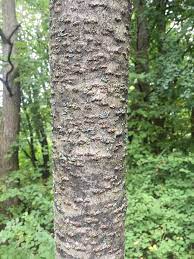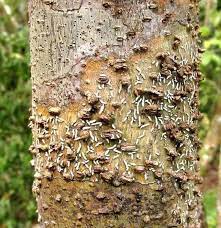Cinnamon lenticels are small, raised, corky structures found on the bark of cinnamon trees (Cinnamomum spp.), particularly Cinnamomum verum, which is commonly known as true cinnamon or Ceylon cinnamon. Lenticels play a vital role in the exchange of gases, such as oxygen and carbon dioxide, between the inner tissues of the tree and the external environment.
Cinnamon lenticels appear as small, round to oval-shaped, slightly raised spots or pores on the bark of the cinnamon tree. They are typically tan to light brown in color and have a corky texture. Lenticels vary in size, typically ranging from a few millimeters to a centimeter in diameter. They are distributed across the bark surface of the cinnamon tree, forming a pattern that aids in efficient gas exchange.
Lenticels serve as channels for the exchange of gases (especially oxygen and carbon dioxide) between the internal tissues of the tree and the surrounding atmosphere. This exchange is crucial for the respiration and metabolism of the tree.
Oxygen is taken in through lenticels to support cellular respiration within the tree, while carbon dioxide, a byproduct of respiration, is released to the outside. This process helps maintain the necessary levels of oxygen and carbon dioxide for the metabolic activities of the tree. The corky nature of lenticels helps protect the underlying tissues from excess water loss and pathogens. Lenticels can enlarge as the tree grows, allowing for continued gas exchange even as the bark expands and thickens.
Understanding and studying cinnamon lenticels is important not only for the tree’s physiological processes but also for agricultural and horticultural purposes, as it helps in managing the health and growth of cinnamon trees for commercial cinnamon production.
The Economic Importance and Uses of Cinnamon Lenticels

Cinnamon lenticels are small pores or openings found on the surface of the bark of cinnamon trees, particularly Cinnamomum verum or Cinnamomum cassia, from which cinnamon is obtained. While the lenticels themselves do not hold significant economic importance or direct uses, they are associated with the overall growth and health of cinnamon trees, which in turn contribute to the economic value and various uses of cinnamon as a spice and medicinal herb. Let’s explore these aspects:
1. Cinnamon Spice Production: Cinnamon is one of the most valuable and widely used spices globally. The bark of cinnamon trees, including the lenticel-rich areas, is harvested and processed to obtain cinnamon spice. The lenticels can be a part of the bark that is harvested.
2. Medicinal Applications: Cinnamon has various medicinal properties and is used in traditional and modern medicine. It is believed to have anti-inflammatory, anti-microbial, and antioxidant properties. The bark, which contains lenticels, is used to make extracts, powders, and essential oils for medicinal purposes.
3. Culinary Uses: Cinnamon is a versatile spice used in both sweet and savory dishes. It enhances the flavor and aroma of a variety of foods, including desserts, beverages, curries, and stews. The bark, with lenticels, is ground into cinnamon powder or used in its whole form for culinary applications.
4. Aromatic Industry: Cinnamon is valued for its distinctive and pleasant aroma. The essential oil derived from cinnamon bark, which contains components like cinnamaldehyde, is used in perfumes, aromatherapy, and the fragrance industry.
5. Pharmaceuticals and Cosmetics: Cinnamon extracts and essential oil find applications in pharmaceuticals, cosmetics, and personal care products. It is used in toothpaste, mouthwashes, lotions, and soaps due to its aromatic and antibacterial properties.
6. Flavoring and Beverage Industry: Cinnamon is a popular flavoring agent in beverages such as teas, coffees, and liqueurs. It adds a distinct taste and aroma to these products.
7. Traditional and Herbal Medicine: In traditional medicine, cinnamon has been used to treat a variety of ailments, including digestive issues, colds, and respiratory problems. Lenticels contribute to the composition of the bark used in these remedies.
8. Antimicrobial and Preservative Properties: Cinnamon, due to its natural antimicrobial properties, is sometimes used to extend the shelf life of certain food products. It can inhibit the growth of bacteria and fungi.
Read Also: 23 Medicinal Health Benefits of Melastoma malabathricum (Malabar melastome)
9. Health Supplements: Cinnamon supplements, often made from the bark and therefore incorporating lenticel-rich areas, are popular as dietary supplements. They are believed to aid in managing blood sugar levels and improving overall health.
The Products and By-products That Can Be Derived From Cinnamon Lenticels
Cinnamon lenticels are small pores found on the surface of cinnamon bark that facilitate gas exchange and the release of essential oils. While cinnamon itself is the primary product derived from cinnamon bark, various by-products can also be obtained during the processing of cinnamon bark.
Here’s a list and explanation of products and by-products that can be derived from cinnamon lenticels:
1. Cinnamon Powder (Primary Product): Cinnamon powder is the most common and widely used product derived from cinnamon lenticels. The bark is ground into a fine powder and used as a popular spice in cooking and baking, as well as in traditional medicine.
2. Cinnamon Oil (Essential Oil): Cinnamon oil is an essential oil extracted from the cinnamon bark, including the lenticels. It is a highly concentrated aromatic oil used in flavoring, aromatherapy, and in the production of various cosmetic and medicinal products.
3. Cinnamon Extracts: Extracts derived from cinnamon bark, including lenticels, are used in the production of dietary supplements, food flavorings, and medicinal applications. These extracts are typically concentrated forms of the bioactive compounds present in cinnamon.
4. Cinnamon Flakes: Cinnamon flakes are produced by drying and cutting cinnamon bark, including the lenticels, into small pieces or flakes. These flakes can be used in various culinary applications and tea infusions.
5. Cinnamon Sticks: Whole pieces of cinnamon bark, often including lenticels, are used to make cinnamon sticks. These sticks are used in cooking, baking, and beverages, imparting a distinct flavor and aroma.
6. Cinnamon Tea: Dried cinnamon bark, including lenticels, can be used to make cinnamon tea. The tea is made by steeping the bark in hot water, providing a warm, aromatic beverage.
7. Cinnamon Capsules/Tablets: Ground cinnamon bark, sometimes derived from lenticels, is encapsulated or compressed into tablets for use as dietary supplements, often promoting various health benefits.
8. Cinnamon Infused Oil: Cinnamon-infused oil is made by infusing cinnamon bark, including lenticels, in a carrier oil. This infused oil is utilized in culinary applications and for massage or aromatherapy purposes.
9. Cinnamon Syrup or Cinnamon Extract Syrup: Extracts derived from cinnamon lenticels can be concentrated and combined with a sweetener to create cinnamon-flavored syrups. These syrups are used as flavorings in beverages and desserts.
10. Cinnamon Soap and Cosmetics: Cinnamon oil and powder can be used as ingredients in the production of soaps, lotions, creams, and other cosmetic products due to their aromatic and skin-beneficial properties.
11. Cinnamon Incense: Ground cinnamon, including lenticels, can be used to create cinnamon-scented incense sticks or cones, which are commonly used for aromatherapy and relaxation purposes.
12. Cinnamon Flavored Alcoholic Beverages: Cinnamon bark, including lenticels, can be used in the production of flavored alcoholic beverages such as cinnamon-flavored whiskey or liqueurs.
In conclusion, by-products from processing cinnamon bark, including lenticels, may include bark residues, which can be used as compost or in the production of other natural products like mulch or even as a source of additional bioactive compounds. The utilization of by-products helps reduce waste and maximize the value extracted from the cinnamon bark.
Read Also: What Are the Benefits of Crayfish?

